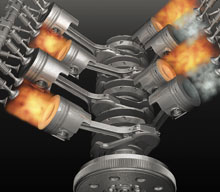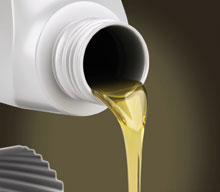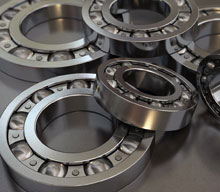Description
Our development is an organo-Bismuth Sulphonate based oil product, which is an environmentally acceptable additive due to Bismuth Sulphonate's non-toxic characteristic, and possesses better EP activities than organo-lead compounds. Bismuth Sulphonate has mild antiseptic and bacteriostatic properties which can be used to introduce a bactericide component into the soluble oil. In an engine, friction may occur as a result of pressure, low speed, and high temperatures or reduced viscosity. All of these conditions may cause the lubricating film, which normally separates moving parts, to become so thin that metal-to-metal contact occurs. Conventionally employed additives to combat this contact may utilize phosphorous, chlorine, zinc, or sulfur containing compounds to reduce friction and to prevent destructive contact between the metal surfaces. It has been discovered that utilizing Bismuth Sulphonate in a base fluid results in a lubricant that noticeably improves the wear characteristics of stock motor oil when added to the same. The Bismuth Sulphonate component has much the same properties as lead, being soft and malleable at relatively low temperatures. Bismuth Sulphonate is also easily deposited on the surfaces to be protected. However, the Bismuth Sulphonate component advantageously has much more desirable characteristics when it comes to pollution.
The next generation of passenger car motor oil and heavy duty diesel engine oil categories will require equivalent anti-wear properties but with lower levels of phosphorus and sulphur in the formulations in order to reduce contamination of more stringent pollution control devices. It is well known that sulphur and phosphorus containing additives impart anti-wear properties to finished oil, and also may poison or otherwise reduce the effectiveness of pollution control devices. Tests have been conducted which show that Bismuth Sulphonate has a much higher extreme pressure property in Gear oils than the traditional Lead Naphthenate. This phenomenon is believed to be a result of the lower melting points of the Bismuth Sulphonate alloys formed during the high load, high temperature and sliding conditions in a typical Extreme Pressure application.
Bismuth Sulphonate has a crystal structure similar to that of Antimony based on a rhombical space lattice. It is considered to be a metal; however, it has properties similar to semi-metals.
The atoms in the Bismuth Sulphonate crystal lattice are more flexible and the metal is more reactive. This can also account for the good E.P. properties of Bismuth Sulphonate.
Yet still another object of this invention illustrates the novel uses of Bismuth Sulphonate as a new class of anti-wear/extreme-pressure (EP) additives which can partially or totally replace sulfurized, phosphorus, chlorinated, zinc, potassium-borate, molybdenum disulfide, graphite or tungsten disulfide based additives, in a wide variety of lubricants with superior results.
Applications
- All Type Of Engine Oils – Petrol and Diesel
- Gear Oils
- Industrial Lubricants
- Marine Diesel Oils
- Hydraulic Fluids
- Chain Oils
- Two-Cycle Engine Oils
Characteristics
- Environmentally Friendly
- Contains No Sulphur, Phosphorous, Boron, Zinc, Chlorine, Lead etc
- Superb Anti-Wear and Extreme Pressure Properties
- Excellent Thermal Resistance and Oxidation Stability
- Outstanding Anti-Corrosion Properties
- Reduce Contamination of Pollution Control Devices
- Protect Yellow Metals
- Works at Various Speeds
- High Temperature Tolerances
- Significantly Increase Oil Life
- Water Insoluble
- Biocide
Physical properties
| Physical State (20 °C) | : | Liquid |
| Colour | : | Dark Brown |
| Odour | : | Characteristic |
| Boiling Point/Range | : | No data available |
| Melting Point/Range | : | No data available |
| Decomposition Temperature | : | >200 °C |
| Flash Point | : | Opened cup: 130°C minimum (Std: ASTM D-92/90) |
| Density | : | (25℃): 1,17g/cm³ (Std : ASTM D-1298/85) |
| Solubility Solubility in water | : | Insoluble (25℃) |
| Solubility in solvents | : | Soluble in: Paraffinic or naphthenic oils |
| Other Data | : | Viscosity (40℃): 180 cSt (Standard: ASTM D-445/88) |























